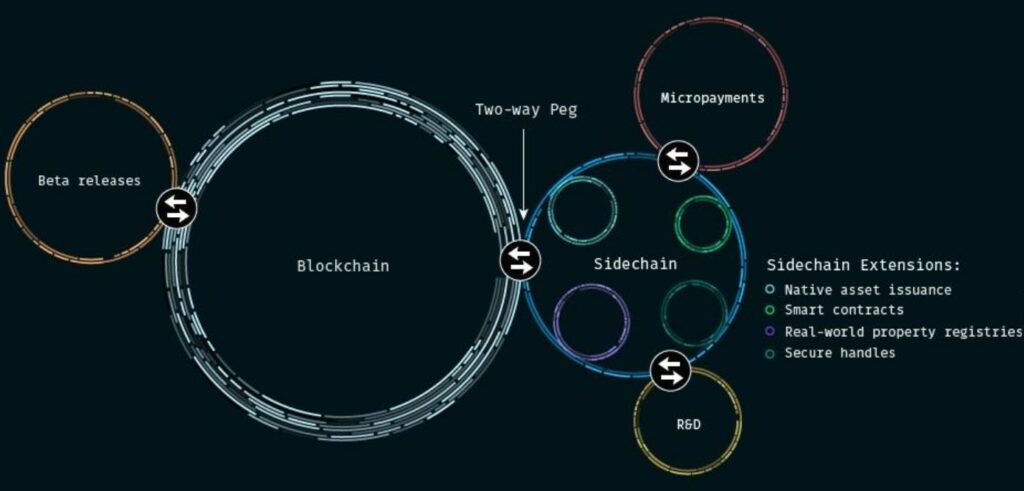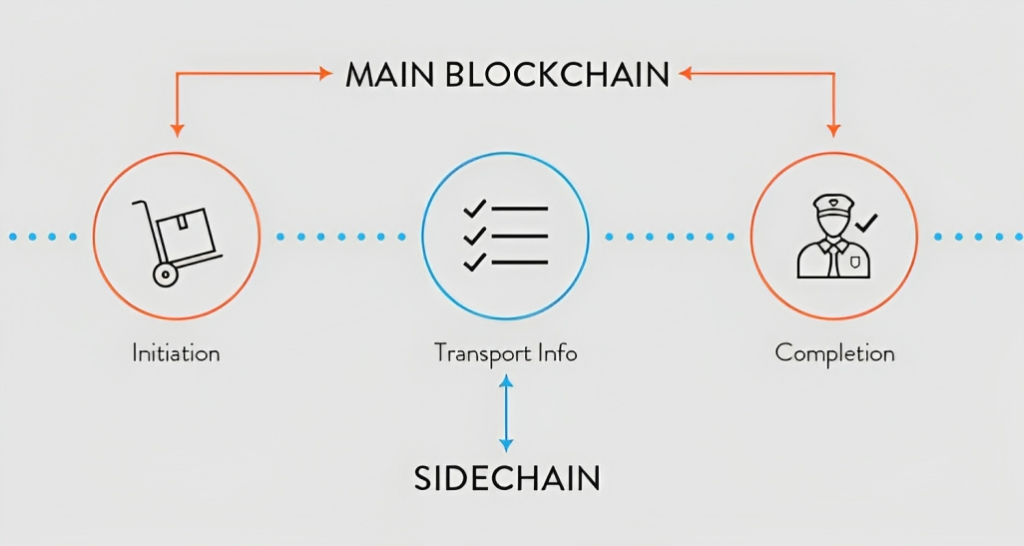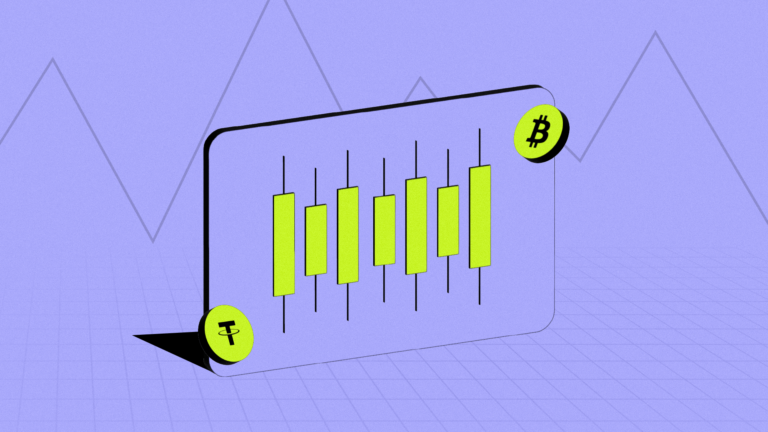- Sidechains are alternative blockchains that interact with a primary blockchain, with two fundamental types: independent blockchains and interdependent chains.
- Sidechains interact by facilitating asset exchange through a 2-way peg mechanism. This peg allows assets to move between blockchains securely.
- The mechanism for transferring assets through a 2-way peg is often referred to as a bridge. These bridges are not limited to asset transfer but also enable asset exchange between chains.
How do you handle being stuck in traffic on a highway? Perhaps you yearn for an escape route, don’t you? If there were a side street or a service road available to evade the traffic, things would certainly become more manageable.
Major blockchains such as Bitcoin and Ethereum resemble busy highways; they often encounter congestion and sluggishness during high-traffic periods. Sidechains, resembling service roads, run parallel to the main highway and offer an alternate route—one that avoids prolonged waits in traffic. Therefore, these play a vital role in scaling blockchain networks.
This article will delve into the concept of sidechains, their functionality, and the primary sidechain implementations. Let’s commence.
What Are Sidechains?
Scale chains, commonly known as sidechains, represent a crucial advancement within blockchain technology, aiming to bolster scalability and adaptability. They serve as distinct blockchains linked to the primary blockchain (referred to as the parent chain) through a two-way peg.

This distinctive arrangement empowers them to function autonomously, handling transactions and data storage independently of the main chain, effectively tackling issues concerning scalability and tailored configurations.
▪️ Distinct Blockchain Interconnected with Main Chain: A sidechain constitutes a separate blockchain that operates simultaneously alongside the primary blockchain, interconnected via a two-way peg. This linkage facilitates secure transfers of assets and data between the sidechain and the main chain, broadening the capabilities of the original blockchain.
▪️ Autonomous Functioning: Sidechains function autonomously, employing their unique consensus mechanisms and security protocols distinct from the primary blockchain. This autonomy permits experimentation and advancement without exerting any impact on the performance or security of the main blockchain.
▪️ Adaptable Characteristics: These chains are customizable to suit particular requirements, whether it involves expedited transaction speeds, heightened privacy, or distinct functionalities within smart contracts. This adaptability renders them suitable for diverse applications and a wide array of use cases.
How Does a Sidechain Operate and What Sets It Apart?
Sidechains distinguish themselves by their capacity to redirect transactions and operations away from the primary chain, functioning with distinct regulations and structures. This segregation plays a pivotal role in tackling certain inherent constraints of conventional blockchains, such as scalability and adaptability.
▪️ Two-Way Pegging System: The two-way peg stands as a vital aspect enabling the transfer of assets between the primary blockchain and the sidechain. Assets can be locked on the primary chain while simultaneously being unlocked on the sidechain, and vice versa, facilitating interoperability and asset transfer.
▪️ Tailored Consensus Protocols: These scale chains have the flexibility to adopt diverse consensus mechanisms compared to the primary chain, customized to meet their specific needs. For instance, a sidechain might employ a swifter or more energy-efficient consensus mechanism than the main blockchain, thereby boosting performance for particular applications.
▪️ Improved Scalability and Effectiveness: By managing transactions on a separate chain, scale chains alleviate congestion on the primary blockchain. This segregation significantly enhances transaction throughput and diminishes latency, benefiting both the sidechain and the primary blockchain.
Advantages of Sidechains
These scale chains present numerous benefits, appealing to businesses and developers aiming to optimize their utilization of blockchain technology.

▪️ Enhanced Scalability: By handling transactions autonomously, sidechains address the scalability challenges inherent in the primary blockchain. Consequently, transaction speeds improve, leading to an overall more scalable network.
▪️ Greater Flexibility and Customization: Sidechains enable the establishment of tailored environments suitable for specific applications or purposes. This capability allows developers to explore various functionalities without impacting the primary blockchain.
▪️ Improved Security: Despite their independent operation, sidechains can still leverage the robust security measures of the primary blockchain. This dual-layer security approach ensures a secure setting for both transactions and data storage.
Industries or Applications Employing Sidechains
Sidechains find diverse applications across industries, addressing specific hurdles and bolstering the capabilities of blockchain technology.
▪️ Financial Services: Within finance, sidechains expedite transaction processing, enhance transactional privacy, and streamline cross-border payments. They empower financial institutions to trial novel blockchain features while safeguarding their primary network’s integrity.
▪️ Supply Chain Management: Sidechains employed in supply chain management streamline real-time tracking, authentication, and automation of logistics procedures. They offer a scalable solution for managing intricate supply chain data among multiple stakeholders.
▪️ Gaming and NFTs: In the realm of gaming and NFT marketplaces, sidechains facilitate high-volume transactions and unique token functionalities without burdening the primary blockchain. This application is pivotal in supporting the dynamic and high-traffic nature of gaming and digital collectibles markets.
Sidechain Development Utilizing Blockchain Protocols
Various blockchain protocols present diverse sets of tools and features tailored for constructing sidechains, addressing a wide array of requirements and specifications.
▪️ Ethereum: Renowned for its extensive smart contract capabilities, Ethereum stands as a preferred platform for constructing sidechains, particularly for applications demanding intricate contract functionalities. Sidechains built on Ethereum can leverage the network’s robust ecosystem, offering tailored features and enhanced scalability.
▪️ Polygon: Engineered with a focus on interoperability and scalability, Polygon proves suitable for crafting scalable solutions that necessitate interactions across multiple blockchains. Through Polygon Supernets, enterprises can establish blockchain networks designed for specific purposes.
▪️ Avalanche: Engineered to expedite and enhance the confidentiality of transactions, Avalanche is well-suited for financial applications. Avalanche Subnets serve as a valuable scaling solution for pioneering web3 applications spanning gaming, finance, and NFT ecosystems.
Conclusion
Having gained an understanding of sidechains and their functioning, it’s opportune to delve deeper. The efficacy of layer-2 solutions such as Arbitrum and Optimism in scaling Ethereum, their parent chain, determines the success of these chains, contingent upon robust security measures, high decentralization, and seamless interoperability.
Upon addressing these aspects, widespread adoption of sidechains is foreseeable, especially since networks like Ethereum and Bitcoin demand progressive scaling.
To learn more about Sidechains, go check out SunCrypto Academy.
Disclaimer: Crypto products and NFTs are unregulated and can be highly risky. There may be no regulatory recourse for any loss from such transactions. All content provided is for informational purposes only, and shall not be relied upon as financial/investment advice. Opinions shared, if any, are only shared for information and education purposes. Although the best efforts have been made to ensure all information is accurate and up to date, occasionally unintended errors or misprints may occur. We recommend you do your own research or consult an expert before making any investment decision. You may write to us at [email protected].





